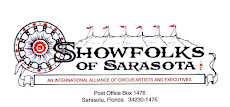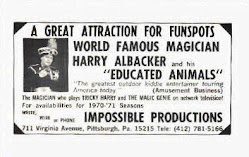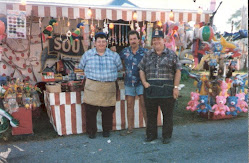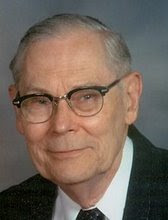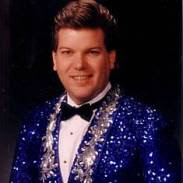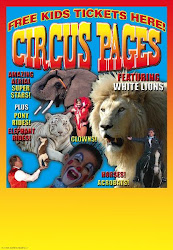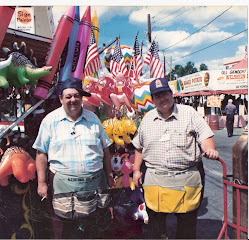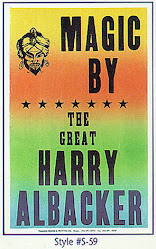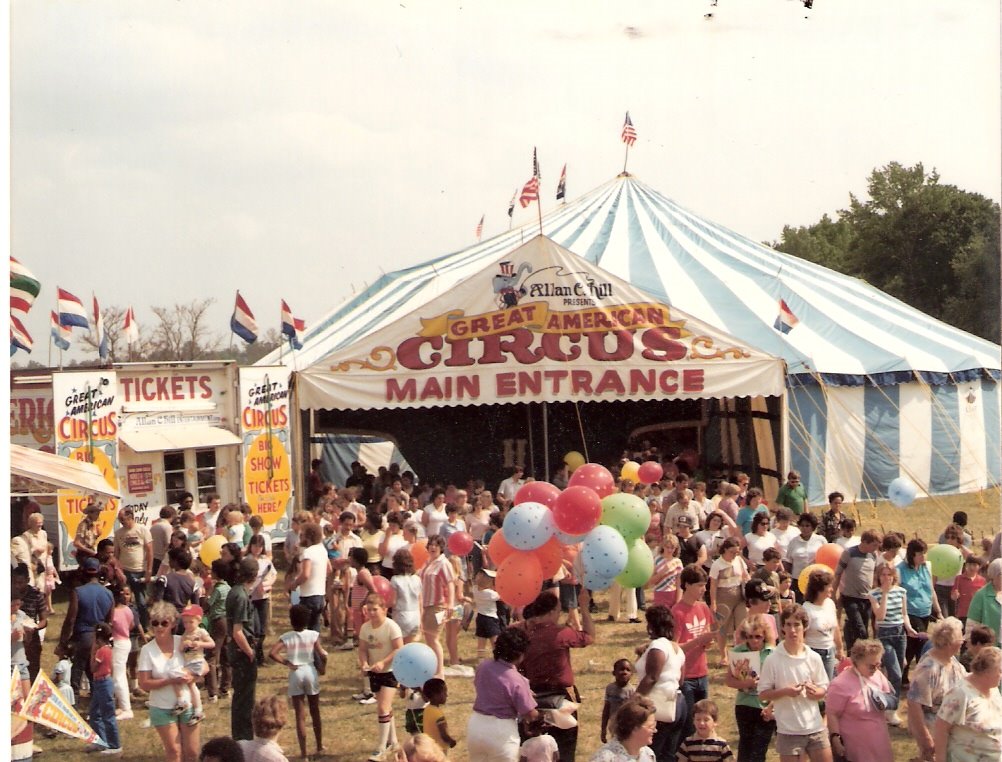
SAVE THE DATES



Saturday, November 5, 2011
 This South American creature looks like a streamlined woodchuck. It can grow to more than four feet long and weigh over 100 pounds, making it the world’s largest rodent. Bob, a member of that illustrious species, is now appearing in the Big Apple Circus, along with Percy, a crested porcupine, the biggest rodent in Africa.
This South American creature looks like a streamlined woodchuck. It can grow to more than four feet long and weigh over 100 pounds, making it the world’s largest rodent. Bob, a member of that illustrious species, is now appearing in the Big Apple Circus, along with Percy, a crested porcupine, the biggest rodent in Africa.I thought that perhaps this one-ring circus, which has never had lions or tigers, was laying its own claim to exotic wildlife. Or maybe Bob and Percy relate to this year’s theme, “Dream Big.” If you can’t offer big cats, why not go with really big rodents?
Whatever prompted these animals’ debut, they add welcome surprise to the delightful “Dream Big,” which recently opened at Lincoln Center under Guillaume Dufresnoy’s artistic direction, with Renaud Doucet as stage director and choreographer. “Dream Big” does have big elements, among them the voice of Jenna Robinson, its Ethel Merman-esque ringmistress. She portrays a wacky professor, with a massive machine that brings fantasies to life. (André Barbe designed the steampunk-style set and costumes.)
Some of those dreams evoke outsize awe and suspense. The members of the Shandong Acrobatic Troupe may miss an occasional landing, but they achieve so much else — like jumping rope while in the form of a human pyramid — that it hardly matters. The magicians Scott Nelson and Muriel Brugman present some well-worn comedy but compensate with a few astounding illusions. And the Flying Cortes, a returning trapeze troupe, made me grateful for the net beneath them; their nerves didn’t require it, but mine did.
Yet “Dream Big” retains Big Apple’s signature intimacy. Children grow wide-eyed as the beautiful Arabian horses in “Galloping Graces,” an act led by the trainer Jenny Vidbel, lean over the ring’s edge and breathe gently on their upturned faces. And some performers go into the crowd, like Barry Lubin, who, in his final season as the clown Grandma, selects an adult for comic lessons in swigging and spewing water.
 The juggler Dmitry Chernov in “Dream Big.”
The juggler Dmitry Chernov in “Dream Big.”Young audience members get turns in the spotlight too, though it isn’t hard to guess that one is a plant. I won’t reveal her performance, except to say that it’s extraordinary. She’s 10 and tiny, but clearly she’s been dreaming big.
The Big Apple Circus runs through Jan. 8 at Damrosch Park, 62nd Street between Columbus and Amsterdam Avenues, Lincoln Center; (888) 541-3750, bigapplecircus.org.
 Matthew Perry, of Flint, Mich., gets the Yo-Yo ready for Swampfest. The spinning ride has chairs that dangle by chains.[Photos by STEPHEN J. CODDINGTON Times]
Matthew Perry, of Flint, Mich., gets the Yo-Yo ready for Swampfest. The spinning ride has chairs that dangle by chains.[Photos by STEPHEN J. CODDINGTON Times] Allan Bello, with Wade Shows, installs lightbulbs on a carousel for the festival that was started by Land O’Lakes High School athletic boosters.
Allan Bello, with Wade Shows, installs lightbulbs on a carousel for the festival that was started by Land O’Lakes High School athletic boosters.Organizers say losing the Flapjack Festival created an opportunity for the booster club to establish its own fundraising event — and provide Central Pasco with a festival it could be proud of.
"We feel we've filled the void," said Swampfest organizer Mike Connor, the booster club president. "We are Land O'Lakes' community event."
The event kicks off today with a youth night headlined by the local band Culprit, which recently won a battle of the bands at a Hillsborough County Fair. The music continues from 10 a.m. to 11 p.m. Saturday, touching on every genre from country to jazz. On Sunday, local dance troupes will show off their moves throughout the day.
The event will also have more vendors than ever, many of which are nonprofit organizations and school groups raising money, Connor said.READ MORE:http://www.tampabay.com/news/humaninterest/land-olakes-welcomes-biggest-swampfest-yet/1199946
Soules took Historic City News editor Michael Gold behind the scenes, so our readers could get a glimpse of the scope of repairs recently completed.
Working on the C. W. Parker, 1927 frame, new wood carousel, is a labor of love for Soules; who inherited the old-fashioned carnival ride from his brother, Jerry.
At the time of his death, Gerald Soules was living in North Las Vegas and working at the Circus, Circus Hotel and Casino performing a dog act under the big top. One night, in June of 1992, a man broke in to Jerry’s home, burglarized the trailer then murdered him.
Jim Soules was employed as a deputy sheriff and K-9 trainer in south Florida when he got word of what had happened to Jerry. The sheriff gave him time off to travel to Nevada and assist local authorities in their investigation. Jerry’s killer was found, convicted and now serving his prison sentence.
When Jim Soules returned to Florida, the ride, reminiscent of old time circuses and county fairs, was in service at a zoo in Fort Wayne, Indiana. Soules brought the portable carousel to St. Augustine, and, after some minor controversies and objections, received approval and a lease from the City of St. Augustine.
Soules says operating the ride is something he does for his brother’s memory. “I operate the ride for Jerry,” Soules said. “There’s no way you could pay salaries, rent, and operating expenses for $1.00 a ride and think you were going to make a profit.”
When asked, Soules said that his children all have jobs and he doesn’t think they would want to run the carousel when he gets ready to retire — again. Soules, assisted by Wilson Machine Shop in St. Augustine and one other employee, does all the engineering and repairs on the ride required to keep the it safe and fun for his loyal patrons. “I don’t think I’ll sell it,” Soules told Historic City News. “I’ve probably got another twenty years in meread more:http://www.historiccity.com/2011/staugustine/news/florida/riders-excited-carousel-resumes-today-20402
It’s certainly animated. And it has drama, daredevil feats and a musical score all its own. But it’s not a computer-generated image.
It’s all live and in-the-moment at the 141st Ringling Bros. and Barnum & Bailey Circus in town for performances through Nov. 13 at the Allstate Arena, and Nov. 16-27 at the United Center.
“I think the fact that the circus is all real is what has made it so enduring,” said Ringmaster Brian Crawford Scott. For thrillseekers accustomed to being entertained by something created in a lab and projected on a screen, the circus offers an electric experience without high-tech electronics.
“Everything we do in the circus is real, there are no special effects. There’s nothing fake,’’ said Scott, the 25-year-old ringmaster who is marking his first anniversary with the circus this month.” Those guys really are balancing on tiny wires,” Scott said. “And somebody else is really being launched across an arena while flames light up his back.” More about that later.
“I think that’s why the circus is such great entertainment . . . everything is tangible,” Scott said.
This year’s “Fully Charged” three-ring circus has the traditional circus features that crowds expect including Bengal tigers who follow their trainer’s every command, skillful horse troupes and a pack of pachyderms who show off their finer dance steps. READ MORE:http://www.suntimes.com/entertainment/8477351-421/with-a-circus-the-thrill-is-that-it-is-all-real.html
Director Hanita-Caroline Hendelman and art director David Berry established the Israel Circus School in 2002 in Kfar Yehosuha in Northern Israel. The school holds professional trainings in acrobatics, clowning and all areas of circus arts. They have regular classes throughout the year for youth and adults and a variety of social and multicultural projects. At the school Muslims, Jews, Ethiopians, Russians, Druze and Christians come together to juggle, jump and laugh.
Apart from the “Climbing Walls” convention, the school has been organizing a cultural integration event called “Day at the Circus” for years for students from Jewish and Arabic schools in Israel to come together and learn about each other. “When they arrive, at first they examine each other,” says Hendelman. But the ice breaks quickly. During lunch break the students are asked to teach each other songs in their own language.
By the time they part, they often exchange telephone numbers, Hendelman says. “We have the same mentality and mind, in the end we get along very well,” says one girl from the Nazareth Arabic school. David Berry agrees: “They all watch MTV and wear Jeans. They look at each other as kids not as Jews and Arabs.”READ MORE:http://us.shalomlife.com/culture/16121/circus-school-builds-trust-between-jews-and-arabs/
One is a ticket wagon and the other two are cage wagons believed to be used in circuses between 1924 and 1930.
They are also the earliest example of tunnel car wagons known to exist. Tunnel cars were also used to move wagons, equipment and animals.
The Kohler Foundation of Wisconsin purchased the wagons from a private collector in Pennsylvania and gifted them to the museum. Kohler had learned of the museum's interest in the wagons after a museum official saw them advertised in a carousel magazine.
The museum has 2/3 of the remaining circus wagons in the world, with over 200 in their collection. It opened in 1959.
Family friend and spokesman John MacDonnell said Mr Ashton died in his caravan in Perth, on tour with his grandson's Circus Joseph Ashton.
''He wanted to die in his caravan and he succeeded, he didn't want to die in hospital,'' he said.
Mr Ashton never had to run away to join the circus - he was born into the family business and went on the road when he was just six days old.
Ashton's Circus was started by his great-grandfather, James Henry Ashton, in 1847.
Mr Ashton lived most of his life in a caravan, only moving into his granddaughter's home in recent years and, as a child, used to ride the circus elephants in the street.
Through the circus he met his wife, Phyllis, whose parents were members of the company. They married when he was 16 and she 17.
Together they toured the country and had three children while on the road - Lorraine, Mervyn and Jan.
After the Second World War, they took the helm and turned Ashton's into Australia's biggest and best-known circus.
In the 1950s, '60s and '70s, they had an enormous entourage of elephants, tigers, lions, monkeys, parrots, a giraffe, bear and even a hyena.
At its peak there were more than 120 people, 80 animals and millions of dollars worth of equipment travelling the country.
There were also trips to New Zealand and Papua New Guinea.
Mr Ashton and his wife, who died 10 years ago, performed as many as 12 acts in the ring, including elephant rider, clown and trapeze artist.
At one stage there were 38 family members working for the circus, building an impressive family dynasty.
Mr MacDonnell said it was accepted that Ashton's was the longest running family-owned circus in the world.
He said Mr Ashton also started Australia's first lion parks - in Bacchus Marsh, Victoria, Loganlea in Queensland and Raymond Terrace, NSW.
For many years they bred and supplied lions and tigers for many parts of the world, Mr MacDonnell said.
They also employed Tommy Hanlon jnr for a short period when he finished his television career.
Mr Ashton represented Australia at the Festival of the World's Greatest Circuses in Monte Carlo.
In 1996, Mr Ashton and his wife were awarded the Order of Australia Medal for services to the entertainment industry and charity.
Friday, November 4, 2011

Nov. 3, 2011
Hi Dick
See picture attached of David McLaren on his 28th Birthday yesterday with one of his presents received from Brian's Circus, also a traditional travel circus from South Africa.David is the director and sole owner of McLaren Circus as well as ringmaster and animalcarer amongst other things.
Cheers
Denzil McLaren
 Circus Vargas will be coming to Santa Anita Park for the first time from Nov. 24 through Dec. 5. (Courtesy photo)
Circus Vargas will be coming to Santa Anita Park for the first time from Nov. 24 through Dec. 5. (Courtesy photo)The City Council on Tuesday granted the animal-free circus a use permit to bring its big-top tent to the racetrack's southwest parking lot for an 11-day run starting Thanksgiving Day.
"As far as I know, this is a first for having a circus on our grounds," said Pete Siberell, who is Santa Anita's director of community service and special projects.
"The timing worked out well as we don't have a lot going on in our lots during the holiday season. And it's kind of a test run for us in the event we want to host a larger show like Cirque du Soleil or Cavalia in the future."
The circus provides animal-free entertainment, lighting and music - all inside its 147-foot diameter blue and gold big top tent.
The circus will not bring in a lot of revenue to Santa Anita Park. However, there could potentially be more revenue involved with Cirque de Soleil and its equestrian equivalent, Cavalia, since there could be some "cross-promotion" opportunities with those audiences, Siberell said.
The City Council in September approved expanding the kinds of outdoor events allowed at the racetrack and in the adjacent parking lot areas, including concerts, carnivals and farmers markets. The council is still required to approve any special event held for more than five days.
Shows will start Nov. 24, Thanksgiving Day, and end Dec. 5. The length of each show is about 90 minutes and is expected to draw between 300 and 500 people each performance.
Circus Vargas Locations Director Mark Landon said the circus was excited to find a stage in the western San Gabriel Valley since "we do well with the a more upscale audience," he said.
While many other circuses travel around Southern California - including those from Central America and Mexico - they tend to hit a different audience, he said.
In addition, "we always like a location that has name recognition," he said. "You say Santa Anita Park, everyone in Southern California will know exactly where that is. We like locations that have a certain amount of traffic and visibility."
The show has a cast of about 25 employees, who travel with their families, a school teacher and a school house. There will be a show every evening during its Arcadia run with added afternoon shows on weekends.
The current edition of Circus Vargas, which includes aerialists, acrobats and comedians, takes spectators on "an artistic journey, encompassing the cultures of the world" in a series of vignettes depicting a traveling circus performer, according to Circus Vargas.
The circus will not have mechanical rides, games of chance and alcohol will not be sold or served, according to city documents.
"It's a family show, perfect for parents and little kids," Landon said.
Now a grizzled veteran at age 24, Burton is armed with his knowledge of engineering as he and his team, Young Glory III, participate in their 10th Punkin Chunkin. They've practiced since late summer.
"We started practicing after Labor Day," he said. "We pulled out the cannon, cleaned it up and made sure it was functionally sound. We've had some big shots in our practices as we've been measuring our data. We've got this thing pretty tuned up."
Young Glory III set their first record in 2003 as teenagers when they recorded a distance of 3,945.28 feet. They began using an 8-pound gourd to compete in the adult events, eventually setting the record of 4,483.51 feet and becoming the youngest adult winners in event history.
Burton said the process in which the team developed their cannon was a gradual one during the years.
"We did a lot of recycling, because, at 14, we didn't have a wad of cash," he said. "The original air cannon sat behind the guy's shop for years. We picked through a lot of salvage yards and we steadily built it up. This year, we bought two new valves that were $500 apiece and put on a new actuator. We've probably spent close to $40,000 for items over 10 years, and our cannon is pretty basic compared to some of the other machines you see there. Ours is just straight mechanics as there's no wires or anything high-tech."
Frank Shade, spokesman for World Championship Punkin Chunkin, said the devices used for launching the pumpkins can range from the simple to some of the more elaborate.
"The machine technology has grown immensely over the years," he said. "From using cut-down trees and car engines that used to cost $100, now to vehicles that can cost a quarter of a million dollars if built from scratch. We even have some wooden machines that may not cost more than $200 for tools."
Donny Jefferson and his team, Bad to the Bone, have taken home first place in the centrifugal category for the last 15 years. Jefferson said the device, which they've used for the last decade, has had no alterations made.
"It's just a time-proven method with a lot of consistency," he said. "The biggest thing with any competition is that it all depends if you have the perfect pumpkin or not. It's got to be good, hard and solid and if not, it's not gonna work."
Burton said his engineering background has helped him take a different approach when it comes to launching pumpkins.
"It definitely helps you think outside the box," he said. "There's nothing you can Google about what makes a pumpkin fly so far."
http://www.punkinchunkin.com/
Thursday, November 3, 2011
 Circus patriarch Doug Ashton, pictured here in 2002 on the Gold Coast, has died aged 92. Picture: Adam Head Source: News Limited
Circus patriarch Doug Ashton, pictured here in 2002 on the Gold Coast, has died aged 92. Picture: Adam Head Source: News Limitedby: Staff writer From: AAP November 03, 2011
Doug Ashton, the patriarch of the world's longest family-run circus, died as he lived his life - on tour, in his caravan. Mr Ashton passed away on Thursday morning aged 92, after a year-long battle with cancer.
Family friend and spokesman John MacDonnell said Mr Ashton died in his caravan in Perth, on tour with his grandson's Circus Joseph Ashton.
"He wanted to die in his caravan and he succeeded, he didn't want to die in hospital," Mr MacDonnell told AAP.
Mr Ashton never had to run away to join the circus - he was born into the family business and went on the road when he was just six days-old.
Ashton's Circus was started by his great grandfather, James Henry Ashton, in 1847.
Mr Ashton lived most of his life in a caravan, only moving into his granddaughter's home in recent years and, as a child, used to ride the circus elephants in the street.
Through the circus he met his wife, Phyllis, whose parents were members of the company. They married when he was 16 and she 17.
Together they toured the country and had three children while on the road - Lorraine, Mervyn and Jan.
After World War II, they took the helm and turned Ashton's into Australia's biggest and best-known circus.
In the 1950s, 60s and 70s, they had an enormous entourage of elephants, tigers, lions, monkeys, parrots, a giraffe, bear and even a hyena.
At its peak there were more than 120 people, 80 animals and millions of dollars worth of equipment travelling the country.
There were also trips to New Zealand and Papua New Guinea.
Mr Ashton and his wife, who died 10 years ago, performed as many as 12 acts in the ring, including elephant rider, clown and trapeze artist.
At one stage there were 38 family members working for the circus, building an impressive family dynasty.
Mr MacDonnell said it was accepted that Ashton's was the longest running family-owned circus in the world.
He said Mr Ashton also started Australia's first lion parks - in Bacchus Marsh, Victoria, Loganlea in Queensland and Raymond Terrace, NSW.
For many years they bred and supplied lions and tigers for many parts of the world, Mr MacDonnell said.
They also employed Tommy Hanlon Jnr for a short period when he finished his television career.
Mr Ashton represented Australia at the Festival of the World's Greatest Circuses in Monte Carlo.
In 1996, Mr Ashton and his wife were awarded the Order of Australia Medal for services to the entertainment industry and charity.read more at:http://www.heraldsun.com.au/entertainment/arts/circus-patriarch-doug-ashton-dies-in-his-caravan/story-fn7euh6j-1226184724073
It also received the Best Films4Families Feature Award at Seattle International Film Festival, the Audience Choice Award for Best Feature Documentary at Woods Hole Film Festival, and an Indie Spec Special Recognition Award at Boston International Film Festival.
It screened to enthusiastic crowds at the Real Art Ways Cinema in Connecticut, Frontier Cafe Cinema in Maine, at WRIF and the Norwich Public Library in Vermont, NewportFILM in Rhode Island, ANDkids World Film Festival in Indiana and at the Sarasota Film Festival in Florida!
 Animal encounters and more at the Coastal Empire Fair
Animal encounters and more at the Coastal Empire FairThe annual fair, now in its 62nd year, runs today, Friday and through the weekend at the sprawling fairgrounds off Meding Street.
The event features the requisite carnival rides, traditional fair games and funnel-cake/corn dog fare. But one of the biggest draws are the free Brian Staples animal encounter shows and animal magic shows. Multiple shows are held each day through Sunday.
Brian Staples, founder of Staples Safari Animal Rescue, said he and his animals have been providing entertainment at the Coastal Empire Fair for 10 years.
“It’s like a family reunion every year with people who have been coming to the fair for years,’’ said Staples. “People remember when the show’s white tiger was a baby and they could pick the tiger up.”Now that “baby” tiger weighs 550 pounds. Staples emphasizes that his animal shows don’t involve circus tricks or goofy antics. Instead, the goal is to present an interactive show and let the audience see the animals doing the amazing things they do in the natural world, Staples said.
Different shows feature different animals.You might see a tarantula placed in a child’s hand. Or find yourself just a few feet away from a 15-foot snake, a monkey cracking nuts or a macaw flying.
Staples’ animal shows help him to rescues and house animals that could not have been returned to the wild. He and some of his animals have been featured on various TV shows including “The Tonight Show” last month, Animal Planet, The Discovery Network and the National Geographic channel. More information at staplessafari.com.
Other free entertainment at the fair include Rosaire’s Racing Pigs, 4-H livestock shows and more.
 Christian Heineking and River of Dreams cleared a fence during Wednesday's competition at the National Horse Show at the Kentucky Horse Park. MATT GOINS
Christian Heineking and River of Dreams cleared a fence during Wednesday's competition at the National Horse Show at the Kentucky Horse Park. MATT GOINSBy Janet Patton
from: www.kentucky.com
Nov 3, 2011
Although the 128th Alltech National Horse Show has barely kicked off, show officials already are hailing the new Kentucky version a success and looking at how they can build on that next year.
"I think we've had a major rebirth," said Mason Phelps Jr., National Horse Show president, as the five-day competition got under way Wednesday. "The enthusiasm and the energy of this horse show are like nothing I have seen in years."
Show treasurer Allan Shore of Bedford, N.Y., said that they were thrilled to see top competitors such as Great Britain's Nick Skelton, who won the Washington International Horse Show's $100,000 President's Cup Grand Prix last weekend, and Christine McCrea, who last week won a gold medal for the United States at the Pan Am Games in Mexico, coming for the Alltech Grand Prix on Saturday.
Read more: http://www.kentucky.com/2011/11/03/1944451/mere-hours-after-starting-national.html#ixzz1cdW1AWXA
Bob Barker touts bill to protect traveling circus animals
At a Capitol Hill news conference, Barker noted that traveling circuses rely heavily on animals that are trained to do tricks, which he said is accomplished with acts of cruelty.
"How do they train them? They have to dominate the animal," Barker said. "How do they dominate the animal? They beat it, with clubs, fists, black jacks, ax handles, golf clubs. They shock it with all sorts of electric devices. They use bull hooks on them they even deprive them of food and even water in order to make them do these tricks."
Barker, who is well known for promoting the cause of animal protection, is championing the Traveling Exotic Animal Protection Act. The bill, which would amend the existing Animal Welfare Act, has attracted bipartisan support.
The bill would affect only traveling shows. It specifically exempts zoos, aquariums and research labs and rodeos.
Rep. Jim Moran, D-Virginia, said that although the issue is not the most pressing concern of the day for Americans, "how we treat animals is a reflection of our nation's moral character."READ MORE:http://www.cnn.com/2011/11/02/politics/barker-circus-animals-bill/
The cast list: 12 cats, 10 dogs, one parrot, three geese and eight people.
It combines vaudeville, Vegas and Russian circus elements for the kind of show never before seen at the Bing Crosby Theater (nor at the Panida Theater in Sandpoint).
Let’s put it this way: Have you ever seen a dog drive a train around the stage?
Popovich, a Moscow Circus veteran based in Las Vegas, said his animal act is not exactly typical.
“We don’t force them to do difficult tricks,” he said by phone. “I just look for personality. … Each pet has some kind of trick inside their body. Some like to play with a ball, or jumping, or climbing.”
Or, in the case of one dog, walking around on his hind legs with a cat riding piggyback.
Sometimes, the “trick” is simply an endearing trait. Popovich said he has one dog who is good at acting lazy. That dog plays a student in a classroom who runs and hides whenever homework is assigned.
Another difference: This show has a plot.read more:http://www.spokesman.com/stories/2011/nov/03/circus-pets/
Wednesday, November 2, 2011
Photo Source:goodriskgovernancepays
CIRCUS FUSION features two hours of non-stop thrills with sound, lights, music & special effects that'll blow you away and keep you on the edge of your theatre style seat.
Submitted by Kristina D'Ambrosio, Community Content Producer
Thursday, October 20th, 2011
Come to the Montgomery County Fairgrounds for the ultimate destination in fun and thrills.
Witness death defying stunts and wacky performances by:
The largest herd of performing camels in the world along with Russian showgirls who will be riding themOka, a 9000 pound Asian elephant and a herd of African & Asian elephantsThe Ukraine Olympic High Bar Team Acrobatic daredevils soar 80 feet in the airMotorcycles that defy gravity along with showgirls on stilts, a comedian. and crazy ballerinas. CIRCUS FUSION has German wheels, Russian swings, African and Asian elephants, Ukraine Olympians, US Motorcycle extreme air-daredevils, Cossack riders and more.
Come early with the family and enjoy the Circus Fun Zone with Elephant, Camel and Pony rides, & a Free Petting Zoo.
Tickets and Show Times are available online at www.CircusFusion.com or by phone at 888-781-4253. All seats are
reserved. Best seats go first. Advance deals include Free Kids & Two-For-One Adult tickets.
CHARLOTTE, N.C. -- We had some real excitement in our studios this morning.
The guest on Larry’s Look was Tim Tv. He breathes fire, does tricks on stilts, lays on a bed of nine inch nails with Larry standing on him, and does it on live television!
He’s in town with Circus Fusion and spent the morning at News Channel 36.
 Harold Burdick, who has been involved with wagon restoration and maintenance at Circus World Museum for 34 years, looks over one of the wagons the museum recently acquired.
Harold Burdick, who has been involved with wagon restoration and maintenance at Circus World Museum for 34 years, looks over one of the wagons the museum recently acquired. SaLoutos, who serves as the ringmaster at Circus World Museum, handed the magazine to Harold Burdick, who has been involved with wagon restoration and maintenance at the museum for 34 years.
"As soon as I read the advertisement, I grabbed my magnifying glass and looked at the wagons," Burdick said. "I knew they were the real thing because I know circus wagons like the back of my hand."
In the magazine, Burdick saw a ticket wagon and two cage wagons he believed were constructed in 1924 and associated with the Cole Bros. Circus from the 1900s.
Brudick decided the wagons would be a perfect fit for Circus World's collection and presented the idea to Circus World Museum Executive Director Steve Freese.
"We just knew we needed to have these wagons," Freese said. "Circus wagons from that time period are really underrepresented in our collection."
Burdick and Freese went to visit with the private collector in March.
"Once I saw the undercarriage and the square bolts of the wagons I knew these wagons were the real deal," Burdick said. "There are not many wagons out there like these. I am really excited we were able to get them for our museum."
And with financial help from the Kohler Foundation of Wisconsin, the wagons arrived at the Circus World Museum late last month.
Freese said they are the first wagons added to museum's collection since 2002, which now features 218.
He said one of the cage wagons shows claw marks.
"Even though it was repaired, the claw marks are still visible," Freese said. "That's history right there. We know from looking at historic pictures that these wagons once carried animals - bears or tigers."
He said there are no other wagons in the museum's collection that hold such dramatic evidence of what the wagons were used for during their time in service.
"Other than the paint, the wagons are about 90 percent original," Burdick said. "They need very little restoration work, if any."
Burdick said he was fascinated by a brake system on one of the cage wagons.
"It's so unique," Burdick said. "All the rider had to do was put his foot down on a lever and it would activate a pulley and then a steel brake would stop the wagon wheel. A pretty ingenious device for the time this wagon was built."
Freese said the three wagons do not duplicate any others in the museum's collection.
Freese said a small crew from the Kohler Foundation will visit the museum to help clean the wagons before they are placed on display.
“I was born into it,” he says. “When kids would want to run away with the circus, I would want to run away from the circus. That’s just a joke, really. I’m seven generations [of circus performers] on my father’s side, five on my mother’s.”
Growing up, Dubsky, 48, spent his time taking care of the family pets, which were the leopards and panthers his parents trained.
Today, Dubsky works as managing director for Circus America, INC., a company that promotes the Piccadilly Circus show. This fall, Circus America premiered Circus Fusion, which combines the classic look and feel of the American circus found in Piccadilly with the European performance-based styles made popular by Cirque du Soleil. The show features a range of stunts from acrobats launched from a catapult to tricks by the Ukraine Olympic High Bar Team and boasts entertainment from clowns to ballerinas.
Animals such as elephants and camels are also a part of the show. Circus goers who arrive early are welcome to attend a petting zoo with elephants, camels and ponies.
Standing is the legal principle that governs who can sue for any particular damages claim. In order to have standing, a plaintiff must demonstrate that he suffered actual damage (injury), that the conduct of the defendant caused that injury (causation), and that a decision in the plaintiff’s favor will correct or compensate the damage done (redressability).
However, the lower court went further, finding that the various animal rights groups bankrolling the complaint had paid Tom Rider, the lead accuser, $190,000 over the course of the lawsuit. Judge Emmet G. Sullivan wrote at the time:
Beginning in December 2001 and continuing until at least the beginning of 2008, the organizational plaintiffs made payments to WAP [the Wildlife Advocacy Project] for the purpose of funding Mr. Rider. While FFA [The Fund for Animals]/HSUS (Mr. Markarian) testified that it was not certain whether WAP used its “donations” for other purposes as well, this testimony is undermined by the documents underlying FFA/HSUS’s “donations,” which indicate that the money was specifically for use in connection with this litigation. FFA/HSUS’s testimony also is questionable given that in 2003, plaintiffs’ counsel, Ms. Meyer, specifically sent an email to the representatives of the organizational plaintiffs, including Mr. Markarian, requesting funds to support Mr. Rider’s advocacy efforts regarding the elephants and the lawsuit, and expressly suggesting that the funds for Mr. Rider could be contributed to WAP so that they would be tax deductible.
Those findings prompted Feld Entertainment to file a countersuit under the Racketeering Influenced Corrupt Organizations Act (RICO) in February 2010. (Who says the animal rights movement can’t act like a racket?) That suit is still active, although it could be a while before it’s resolved.
When asked by The Washington Post what he thought about the appellate ruling, one of Feld’s attorneys said, “Feld Entertainment is the target today and some other businesses are going to be targets tomorrow, and at some point it has to stop.” He’s dead-on.
Hopefully, Feld’s RICO lawsuit will cause the animal-rights extremists to think twice next time—but we wouldn’t count on it. PETA, after all, went after Ringling Bros. in 2005 for allegedly infiltrating the organization (hypocrisy much?) and saw that suit dismissed. PETA and other animal rightists also claimed in a 2003 lawsuit against the San Diego Zoo that elephants were better off dead than in captivity. And just last week PETA filed a lawsuit against Sea World claiming that they were keeping killer whales as “slaves.” Thank goodness the courts have seen these lawsuits for what they are—a tactic for activists to harass organizations they don’t like. Too bad taxpayers also end up footing much of the bill for these frivolous lawsuits.
Executive director Laura Stansell confirmed that Fern Street will close, but she declined to comment further until she consults her board of directors.
Fern Street Circus was founded in 1990 and has been producing circus shows in Balboa Park every spring since 1991.
Meanwhile, The Center for Amusing Arts and Technomania Circus have found a new home at the recently refurbished Victory Theater (2558 Imperial Ave. in Grant Hill). The historic 1920s theater is also hosting DangerHouse Productions' staging of Fear Beautiful Fear through Nov. 6 and other special events and performances.
"I carved an eagle on top of a 27-foot tree," he said. "I was standing and carving with a 36-inch chainsaw and, occasionally, they kick. If you fall, you fall, so you have to be careful."
Fortunately, the majority of Cox's work is done on solid ground. As one-half of R&S Woodcarving – the other half is his wife, Sue – Cox uses chainsaws to transform large logs and tree stumps into animals, shapes and human silhouettes.
The couple are based in Edinburg, Pa., but spend months each year traveling the country, selling their work and demonstrating their sawing prowess at fairs and craft shows. They've been a staple at the Cape Fear Fair and Expo for years, where their booth resembles a fairy-tale forest populated by black bears, owls, bearded gnomes and horses, frozen in mid-air with wild, thick manes billowing behind them.
The Coxes began their carving business nine years ago after running a mom-and-pop grocery store for more than 30 years. At first, Rick carved the pieces and Sue provided the finishing touches; things like sanding, painting and adding tiny, detailed marks to make fur or faces more realistic.
But eventually, she began carving her own works, and now they both produce pieces regularly, though their tastes vary.
"I do turtles and frogs and all those little bears," Sue said. "I like the cute."
By contrast, Rick prefers the horses. His all-time favorite piece is a 7-foot stallion standing on its hind legs, which he shaped using only a chisel and hammer.READ MORE: http://www.starnewsonline.com/article/20111030/ARTICLES/111039997/1177?Title=Carving-out-a-niche-at-the-Cape-Fear-Fair
Volusia County Fair organizers hope to build on tradition, recent success
Today, that number is nearing half a million, and condos, subdivisions and strip malls dot once-idle land.
But take a drive off the main drag, and you'll still find thousands of acres in Volusia County devoted to pasture, timber, ornamental plants and citrus.
Volusia County isn't all about beaches and racetracks. About a third of the county's 717,000 acres are used for timber and agricultural production, according to statistics provided by the University of Florida's local agriculture extension office.
The fair, which starts Thursday and runs through Nov. 13, is a chance to see this aspect of the community, said David Griffis, extension office director.
"It showcases what we have to offer in Volusia," Griffis said. "It also gives the youth an opportunity to showcase what they have done. If you've ever tried to raise an animal, there are a lot of life skills involved in that."
 from: www.heraldscotland.com Published on 31 Oct 2011
from: www.heraldscotland.com Published on 31 Oct 2011Soon the boastful banners of the circus will decorate the lamp-posts and the hoardings all around our larger villages for the farewell performances of the year.
Then the posters will be stripped for the Loto nights, staple fare once the outdoor tables and chairs are stacked in the slowly emptying restaurants, and the squares take on the deserted look of winter; the heat-hazed fetes a dwindling memory.
Like the last blaze of the summer flowers, the circus flyers emit fierce, vibrant colours and seem to urge one to enter the magic before it’s too late and the mists descend and plunge us into our shuttered dark months of hibernation.
Each time they go up, starting in the spring, I’m drawn to their pictorial brave defiance of the modern world: the red-haired clown and his painted mouth; his sly slapstick humour in a sawdust ring now pitted against the foul-mouthed ‘comedians’ who shout and race across the television and stage as much here as they do in the UK, whose humour is of a personal, cruel and knowing kind; not a gentle poke at our shared human frailty and innate loneliness.
The ageing wire act whose acrobatic feats hold little wonder now to children whose dexterous fingers can spin heroes and villains across cyberspace.
And of course, the animals, now depleted, no longer the heart of the show, caged and prodded for our entertainment.
We know better these days, even here, where the last of the travelling circuses find an audience.
There was a ‘white’ lion – ‘the only one of its kind’ – advertised in one of the bigger circus’s posters earlier this year, and when in residence there is always a camel or two staring and sneering out at the world from its tethered post next to the petanque court.
Horses still prance in feathered head-dresses in ever decreasing circles as the big top gets smaller and smaller.
And ‘girls’, now more matrons in thick pan-stick and straining costumes over bulbous thighs, still smile with arms aloft from the middle of three cantering beasts.
I know all this because each year I’ve wandered around the outskirts of the circus in their familiar fields; peered through the cracking, dirty fold-backs of the tent and drawn in that heady, sweaty mixture of sawdust and bodies.
I’ve seen the Ringmaster owner morph from ticket seller to top-hatted controller of his world, pulling back his shoulders with a tired pride as the cracked entry music blares from an ancient sound system of large horns.
Seen the girls in their too tight leggings and sweat shirts emerge out of their slumped pre-show last fags and coffee to bedazzle in Lycra and sequins, watched by the tiniest of children, the only ones untouched enough to believe in magic.
Again, as so many things do here, it takes me back to childhood in the Ireland of the late 1950s, when the arrival of the circus was the most wondrous event in our year.
Horse mad, we’d beg the wiry, hard eyed men for the privilege of grooming the show horses, nipping between their restless legs with a curry comb, falling in hopeless love with our favourites and fighting, literally, for the honour of leading one in the big parade, wearing our butterfly jodhpurs and starched shirt and tie, far superior to the tail-feathered girls who leapt into the spotlight on to the backs we’d so lovingly polished.
For a brief time we dreamed of a life in the circus until our mothers called us home and life settled back inside the convent walls.
The very old ones here I’ve asked, remember how the circus coming to town somehow made them part of a France they didn’t know, but were now included in.
Then it wasn’t just the children who sat open-mouthed on the benches but the adults too, starved of any glamour or awe in a world reduced to mere survival; a world bounded by farm and village.
Somehow, despite ever decreasing numbers, the circus still exists here in our backwaters. Still conjuring magic and illusion, however shabby in the cruel daylight.
This Christmas in Valence, within a theatre, a circus will put up its canvas top.
Already there is an excitement around it and my hairdresser warns I need to book quickly.
I wonder if I’m too old, too crocked, to run away and be a bare-backed rider? The question was merely rhetorical.
How sad I already know the answer.
Tuesday, November 1, 2011

Pending City Council approval Tuesday, the animal-free circus with entertainment, lighting and music will bring its 147-foot diameter blue and gold big top tent to the racetrack's southwest parking lot for a two week run starting Thansgiving Day.
"As far as I know, this is a first for having a circus on our grounds," said Pete Siberell, who is Santa Anita Park's director of community service and special projects. "The timing worked out well as we don't have a lot going on in our lots during the holiday season. And it's kind of a test run for us in the event we want to host a larger show like Cirque du Soleil or Cavalia in the future."
While it will not bring in a lot of revenue to Santa Anita Park, there could potentially be more revenue involved with Cirque de Soleil and its equestrian equivalent Cavlia and perhaps some "cross-promotion" opportunities with their audiences, he said.
The City Council must approve any special event held for more than five days. Shows would start on November 24, Thanksgiving Day, and end on Dec. 5. The length of each show is about 90 minutes and is expected to draw between 300 and 500 people each performance.
Circus Vargas Locations Director Mark Landon said the circus was excited to find a stage in the Western San Gabriel Valley, since "we do well with the a more upscale audience," he said.
In addition, "we always like a location that has name recognition," he said. "You say Santa Anita Park, everyone in Southern California will know exactly where that is. We like locations that have a certain amount of traffic and visibility."Read more: http://www.pasadenastarnews.com/news/ci_19233963#ixzz1cRgVUrdw

HAMMOND Tickets go on sale in less than two weeks for December performances of the 2011 Orak Shrine Circus in Hammond.
The circus will bring elephants, tigers, lions, monkeys, dogs, aerialists, jugglers and more for nine shows over four days at Hammond Civic Center, 5825 S. Sohl Ave.
Tickets are $20 for reserved seating, $18 for adults and $14 for children 12 and younger. Shows will be Dec. 1 through Dec. 4. Tickets go on sale Nov. 14 and are available at the Civic Center box office and all Strack & Van Til's supermarkets.Read more: http://www.nwitimes.com/news/local/lake/hammond/article_c19b8ae1-facd-5f82-90ac-165e21961e03.html#ixzz1cRhpDdGS
 The Times-Union-Photo by Jon M. Fletcher / Staff - Sisters Tabetha, 9, (cq) and Tori Elie, 11, spin into the evening on the Dream Machine, one of the many mechanical delights at the Duval County Fair, which opened Wednesday at the fairgrounds downtown.
The Times-Union-Photo by Jon M. Fletcher / Staff - Sisters Tabetha, 9, (cq) and Tori Elie, 11, spin into the evening on the Dream Machine, one of the many mechanical delights at the Duval County Fair, which opened Wednesday at the fairgrounds downtown.Can you smell it yet? The aroma of popcorn, the corndogs, the roasted nuts and cotton candy and draft beer and deep-fried stuff that probably shouldn’t be deep-fried defines the Greater Jacksonville Agricultural Fair as much as the rides, the country music and the livestock shows.
 The fair opens Wednesday at the fairgrounds adjacent to EverBank Field and runs through Sunday, Nov. 13.
The fair opens Wednesday at the fairgrounds adjacent to EverBank Field and runs through Sunday, Nov. 13.It’s chock-full of stomach-turning rides, a three-ring clown circus, pig races, alligator shows, baking contests, a beer festival, a rabbit contest, a Mitch Ryder concert and a bingo tournament.
Gayle Hart, vice president of marketing for the fair, said there were 54 rides last year, and she expects a few more this time around.
“If you’re bored at the fair,” she said, “you’ve got a personal problem.”Read more at Jacksonville.com: http://jacksonville.com/entertainment/2011-11-01/story/rides-food-shows-fair-back#ixzz1cRnbAw2u
 The ferris wheel is a landmark at the Balboa Fun Zone. (Mark Boster, Los Angeles Times / June 29, 2006)
The ferris wheel is a landmark at the Balboa Fun Zone. (Mark Boster, Los Angeles Times / June 29, 2006)A group of preservationists has launched a Facebook campaign to halt plans for ExplorOcean, an ocean-themed educational center that would essentially erase the 1930s-era amusement park from the heart of Balboa.
The Fun Zone has become something of a game piece in the debate over whether Balboa has become scruffy and in need of a face-lift, and whether a gleaming new development would kick some needed life into the area.
ExplorOcean officials insist their plans would modernize the Fun Zone and make the area more relevant for future generations. They unveiled their designs publicly last week, including plans that show a Ferris wheel remaining on the waterfront of Newport Harbor.
James Pobog, 60, is among the traditionalists who aren't buying the pitch.
"They're not doing this out of altruism," Pobog said. "Someone's going to make a boatload of money."
The nonprofit Newport Harbor Nautical Museum, which would operate ExplorOcean, plans to rent part of the space — possibly for restaurants and private events — to generate funds to operate the museum. The nearly $40-million multistory museum would include submarine simulators and a 4D theater, where salt mist would be pumped into a room to give guests a proper nautical experience.
As part of his protest, Pobog spends time on Facebook writing slogans below scenic landscape paintings of the Fun Zone, with phrases like "Save the Fun Zone, Stop the Museum Monstrosity."
Some longtime Newport residents say that the museum's plans are out of step with their sense of the community and that they support Pobog's effort.
ExplorOcean President Rita Stenlund said that after visiting the preview center, some people have come around and are receptive to the proposed development.
But Pobog isn't one of those converts.
"It just fundamentally changes the Fun Zone," he said. "It becomes something else."

TO VISIT OUR PAST POSTS--SCROLL DOWN THE SIDE BAR. ALSO LINKS ARE FURTHER DOWN








































